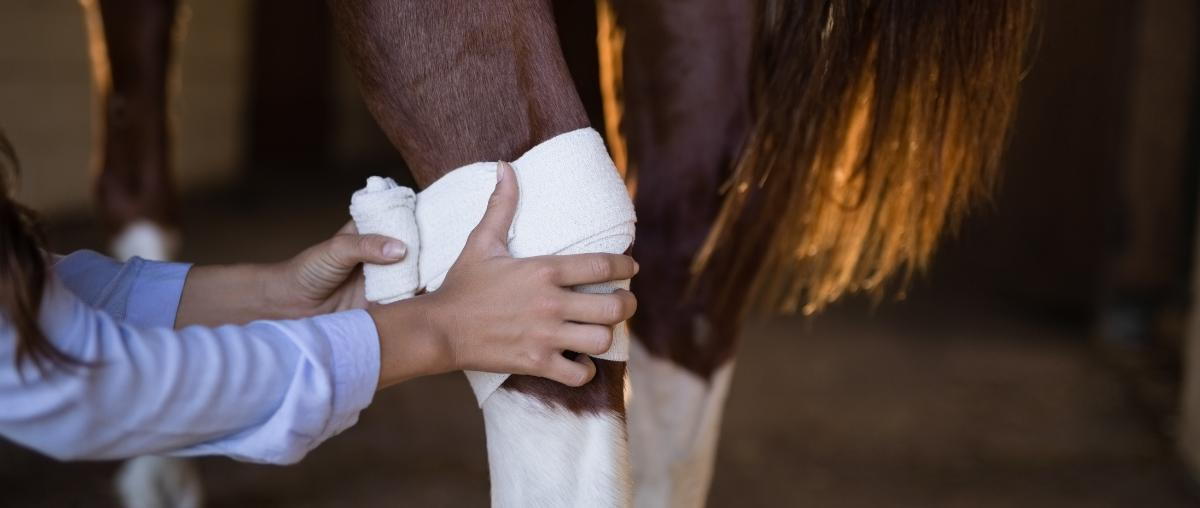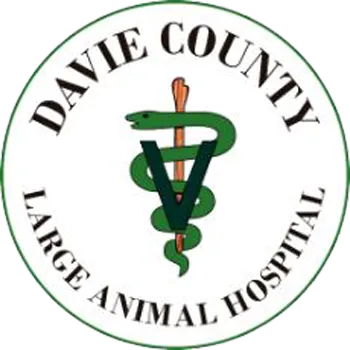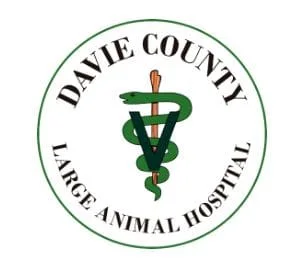DAVIE COUNTY LARGE ANIMAL HOSPITAL

- posted: Jun. 02, 2023
Applying Hock Bandages
A horse uses its hocks in nearly everything it does – from stopping and standing to walking and galloping. Constant use and a prominently exposed point makehocks vulnerable to stress, fatigue and traumatic injury.
Your veterinarian may recommend a hock bandage in any number of situations, such as: following surgery; providing joint support for a weak foal; protecting a wound; or reducing heat and swelling in a strained joint.
Hock bandages are used to:
Prevent or reduce swelling and edema
- Reduce motion in the joint
- Provide support for a weak or injured joint
- Protect a wound or surgical site from contamination or trauma
- Aid in the healing of wounds
- Absorb fluids (exudate)
The Challenge
Applying a hock bandage is not without its challenges. Because of the shape and motion of the joint, it requires special techniques to make the hock bandage safe,secure and effective
Horses also tend to react more to a hock bandage than a lower leg bandage, and may be inclined to kick, fight or fidget. Stay alert and be prepared to move out of harm’s way if the horse reacts adversely to its hock bandage.
As with any type of bandage, a hock bandage can be hazardous if applied incorrectly. There is always the risk of injury to circulation, and to the tendons and ligamentsif the layers are not applied smoothly, evenly and with the right amount of tension.
If you have never bandaged a horse’s legs before, ask your veterinarian or an experienced equine professional to demonstrate the proper techniques. Practice under his or her supervision before doing it on your own.
Bandaging Materials
Because of the bandage’s location, you will need materials that readily conform to the shape of the hock and permit movement without slipping or loosening. If the bandage will cover a wound or surgical site, the materials should also be sterile.
You will need:
- Sterile, Non-Stick Gauze Pads or dressing to cover wounds
- Sheet Cotton, Roll Cotton, or Combine Cotton for padding
- Stretch Gauze or Bandaging Tape such as 3M™ Vetrap™ Bandaging Tape at least 2-3 inches wide for support
- Stretch Adhesive Tape such as Elastikon™, to secure the bandage
Hock Bandaging Guidelines
- Cover the wound or surgical site with sterile, non- stick gauze or dressing.
- Surround the hock with soft, absorbent padding, such as roll or sheet cotton or combine sheet at least two inches thick. Padding should extend 4-6 inches above and below the point of the hock and lie flat and wrinkle-free against the skin.Begin a figure 8 pattern 3ust below the point of the hock by extending the bandage from inside the leg below the point of the hock to the outside of the leg above the point of the hock. Continue the wrap around the back of the leg and then extend itdownward inside to outside.
- Begin wrapping with support fabric well below the point of the hock (approximately one-half inch above the edge of the padding).
- Wrap front to back, outside to inside, spiraling upward (clockwise in right legs, counterclockwise in left legs). Exert just enough pull to stretch the fabric to half its maximum extended length.
- Overlap each preceding layer by 50 percent using smooth, uniform tension to compress the padding without forming lumps or ridges beneath the bandage.
- Repeat this figure 8 pattern working up the leg until the bandage extends 4-6 inches above the point of the hock, covering the padding to one-half inch of the edge.
- Depending on the nature and location of the injury, your veterinarian will advise you whether or not to cover the point of the hock with the support layer. (The horse may be more comfortable if the hock is not completely encased.)
- When bandaging, use enough pressure to minimize swelling and keep the bandage in glace, but never wrap so tightly that you cannot easily slip a finger between the top of the bandage and the tendon that runs up the back of the leg above the point of thehock.
- Do not wrap too loosely as the bandage may slip or fail to do its job.
- Secure the bandage at the top and bottom with an adhesive tape such as Elastikon™
- If you have problems with the hock bandage slipping, begin by wrapping the lower leg from coronet band to several inches below the hock.” This provides a foundation for the hock bandage and will help keep it in place. This technique is especially useful in post-legged (straight-hocked) horses and is usually used when horses have edema or swelling below the hock as well as within the hock area.
| 1 | 2 | 3 | 4 |
| Place thick padding over sterile wound dressing | Place thick padding over sterile wound dressing | Use a figure 8 pattern to bandage around point of hock | Secure bandage with flexible adhesive tape. |
Special Considerations
Because hocks are such vital structures, any injury to the joint or immediate area should be evaluated by a veterinarian.
If a hock bandage is required, do not be disappointed if your initial efforts are less than satisfactory. Even under the best of circumstances, the hock is a difficult place to secure a bandage. Work with your veterinarian, and, if necessary, employ him or her to change the bandage as needed.
Following some additional considerations: · A horse with a condition requiring a hock bandage should be confined to a stall or small run unless otherwise directed by your veterinarian. · Check the bandage several times a day to make sure it has not shifted or loosened. · Make sure the bandage does not cut off circulation, pinch the tendon at the back of the leg, create pressure sores, or cause discomfort. · Monitor and evaluate the horse carefully. If swelling develops above the bandage or at the point of the hock, or lameness increases, contact your veterinarian. · If the horse has an elevated temperature, becomes depressed or irritable, or loses its appetite, consult your veterinarian. ·Change the bandage at least every 2-3 days, or immediately if it becomes wet or soiled.
If you have any further questions or concerns about hock bandaging techniques, contact us.
This brochure was produced through a joint venture between 3M Animal Care Products and the American Association of Equine Practitioners.
Location
Davie County Large Animal
928 Farmington Rd
Mocksville, NC 27028

